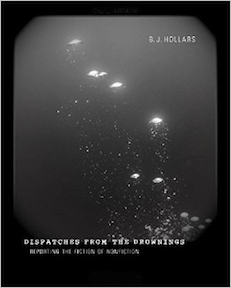By Colin Rafferty
Award-winning author B. J. Hollars (ΦBK, Knox College, 2007) challenges readers with a deceptively straightforward book that explores essential ideas about fact, history, memory, and story. Dispatches From the Drownings is a book that slips under the reader’s skin, haunting them for days to come.
Hollars, a recent transplant to Eau Claire, Wisconsin, where he teaches creative writing at the University of Wisconsin, unearths dozens of stories about drowning victims in old newspapers, most of which are over a hundred years old. Seventy-five of these form the bulk of Dispatches, but in addition to these—and this is the genius of the book—he also writes twenty-five fictional news articles in the same style and voice as the turn-of-the-century originals. He then mixes these fictions with the originals, presenting all of them in a strict chronological order, starting in 1875 and ending in 1922. Hollars provides no clue to the reader as to which are true and which are false; not even the bibliography in the back holds an answer key. To his credit, he avoids any sense of superiority over the reader; at no point does the book feel like a sham or quiz, a clever trick pulled to make the audience feel fooled.
Reading the one hundred articles provides a picture of the capricious nature of life in Wisconsin in the late 19th and early 20th centuries. From the series of drownings, patterns emerge; for a while, accidental drownings are commonplace, followed by a spate of suicides. One article reports on the disappearance of a local boy, and a few pages later, another paragraph breaks the sad news of his body’s discovery. Each spring brings bodies emerging from underneath the winter’s ice. A few are rescued from death by luck or the intervention of others, but they are exceptions, and the book stoically recounts a parade of tragedies, constantly keeping the reader off-balance with its rhythms and disruptions.
Hollars’ narratives—for he has written them all, rewriting the ones taken from the newspaper in a voice appropriate for the time—are accompanied by the photographs of Charles Van Schaick, who staged photographs of Wisconsinites in his Black River Falls studio from 1890 to 1910. Even though no person captured in the wonderfully bizarre pictures is the person in the adjacent news article, the reader’s brain automatically connects the words with the portraits, creating a fiction of its own. The audience is aware of what Hollars does through juxtaposition of article and picture, but cannot avoid the inescapable lure of propinquity; of course the four men stiffly holding guitars on page 113 are also the “Sailing Party Suffers Tragic Losses in Half Moon Lake” of the prior page, even if the reader knows they are not.
Some readers might encounter Hollars’ book as a game—which articles are real? Which articles are fictional? This reading, while certainly possible, oversimplifies Hollars’ goal in collecting these narratives: to a certain extent, they’re all real, and to a certain extent, they’re all fictions. What matters is not the 100 percent accuracy of any particular story (in the introduction, Hollars points out that he tells his nonfiction students that most facts are “about 75 percent true and 25 percent false”), but rather the telling of that story—and all stories—as part of a narrative constructed about the place where one lives.
In an haunting afterword, Hollars writes that he can no longer see the Chippewa River in his new town without viewing it through the lens of its murderousness, without tallying the death toll, without thinking of how a particular spot is “where they found Emery C. Brown and his ice skates,” even if, as Hollars confesses at the end, he can no longer remember which drownings are his fabrication and which ones are part of the historical record. The innocence of Hollars’ admission prevents the book from becoming a giant prank perpetrated upon the reader; if not even the author can know which article is the authentic one, then all the articles gain a certain kind of truth—something beyond the 75/25 split of facts, something that lies beneath the deceptively calm waters of a river.
Colin Rafferty (ΦBK, Kansas State University, 1998) teaches nonfiction writing at the University of Mary Washington in Fredericksburg, Virginia. Mary Washington is home to the Kappa of Virginia Chapter of Phi Beta Kappa.




